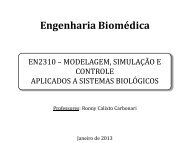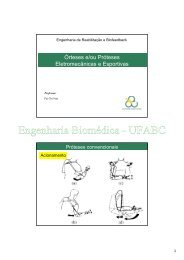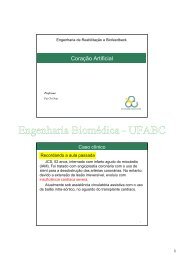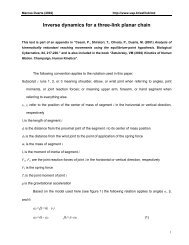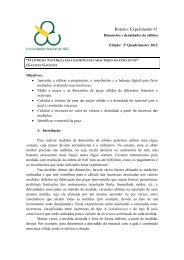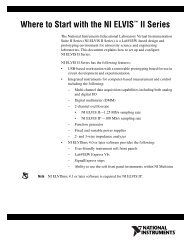M. Duarte, V.M. Zatsiorsky / Physics Letters A 283 (2001) 124–128 125tionless stand<strong>in</strong>g, the authors hypothesized that theprocess should saturate at the region of 10 to 30 s,i.e., no long-<strong>range</strong> <strong>correlations</strong> for time <strong>in</strong>tervals above30 s were expected dur<strong>in</strong>g quiet stance; but the authorsrecognized that longer time series were necessary fora f<strong>in</strong>al conclusion [3]. Recently, an analysis of quietstand<strong>in</strong>g by wavelet statistics has shown different scal<strong>in</strong>gregions (multifractal) <strong>in</strong> short time series [4].One shortcom<strong>in</strong>g <strong>in</strong> the studies of <strong>human</strong> stand<strong>in</strong>gis that quiet stance tasks with the <strong>in</strong>struction “to stayas still as possible” are limited to only a few m<strong>in</strong>utesdue to fatigue. On the contrary, natural stand<strong>in</strong>g overprolonged periods, longer than few m<strong>in</strong>utes, is a verycommon situation <strong>in</strong> daily life, such as stand<strong>in</strong>g <strong>in</strong>l<strong>in</strong>e, or stand<strong>in</strong>g while talk<strong>in</strong>g with somebody. Thisstand<strong>in</strong>g is characterized by repeated changes <strong>in</strong> thebody position, which are self-<strong>in</strong>duced, performed almostunconsciously, and cannot be generally associatedwith any external source. Such natural stand<strong>in</strong>g isnot fatigu<strong>in</strong>g and can be reproduced <strong>in</strong> the laboratoryby a stand<strong>in</strong>g task dur<strong>in</strong>g which a person is allowedto do any movement without any constra<strong>in</strong>t, except tostay with<strong>in</strong> the limited area of the force plate. This unconstra<strong>in</strong>edstand<strong>in</strong>g <strong>in</strong> healthy adults was exam<strong>in</strong>edby Duarte and Zatsiorsky [5] who observed very lowfrequencies <strong>in</strong> the displacement of COP dur<strong>in</strong>g unconstra<strong>in</strong>edstand<strong>in</strong>g, a typical signature of a long-<strong>range</strong>correlation process or long-memory process. Recently,Duarte and Zatsiorsky [6] used the classical rescaledadjusted <strong>range</strong> analysis or R/S statistic [15] to describethe fractal properties of the COP time seriesdur<strong>in</strong>g natural stand<strong>in</strong>g. The average fractal or Hurstexponent (H )was0.35 ± 0.06. In this Letter, weused more robust methods and performed a surrogatetest to quantify the long-<strong>range</strong> correlation phenomenadur<strong>in</strong>g prolonged periods of unconstra<strong>in</strong>ed stand<strong>in</strong>g.<strong>Long</strong>-<strong>range</strong> correlation processes present very longtermfluctuations <strong>in</strong> addition to very short-term fluctuations,where the dependence of data farther apart ishigher than it is expected for <strong>in</strong>dependent data. Thisphenomenon has been observed <strong>in</strong> very diverse areasof nature. Related to biological systems and specificallyto <strong>human</strong>s, it has been observed <strong>in</strong> stride <strong>in</strong>tervalsdur<strong>in</strong>g walk<strong>in</strong>g [7], <strong>human</strong> cognition [8], <strong>in</strong>tervalsbetween rhythmic tapp<strong>in</strong>g movements [9], heartbeatvariability [10,11] and certa<strong>in</strong> DNA sequences[12,13].2. MethodsIn this study, ten healthy subjects (28 ± 5yr,1.79 ±0.09 m, and 78 ± 14 kg) were asked to stand <strong>in</strong> an unconstra<strong>in</strong>edupright bipedal posture on a 40 × 90 cmforce plate for 30 m<strong>in</strong> (the methods were described <strong>in</strong>detail elsewhere [5]). We analyzed the COP trajectoriesfor the anterior–posterior (a–p) and medial–lateral(m–l) direction. Examples of stabilograms (the mapp<strong>in</strong>gof COP a–p versus COP m–l) and a exemplarytime series are shown <strong>in</strong> Fig. 1.The stochastic model of fractional Gaussian noise(or the <strong>in</strong>tegrated function, fractional Brownian motion)is an example of a self-similar process (like afractal) appropriate to model such long-<strong>range</strong> correlationphenomena. This model has been successfullyused <strong>in</strong> many of the above examples and it was usedhere. Several heuristic methods have been suggestedto estimate long-<strong>range</strong> <strong>correlations</strong> s<strong>in</strong>ce the classicalR/S statistics proposed by Hurst <strong>in</strong> hydrology context(for a review of models and methods, see [14]).Two methods were used to estimate long-<strong>range</strong> <strong>correlations</strong>:power spectral analysis (PSA) [14], performed<strong>in</strong> the frequency doma<strong>in</strong>, and detrended fluctuationanalysis (DFA) [10], performed <strong>in</strong> the time doma<strong>in</strong>.The PSA method <strong>in</strong>volves plott<strong>in</strong>g the power spectraof a sample path on a log–log scale. If the samplepath presents long-<strong>range</strong> <strong>correlations</strong> over a <strong>range</strong>of frequencies then significant l<strong>in</strong>ear regression <strong>in</strong> thelog–log plot captures the relation between frequencyand power of the type 1/f −β ,wheref is the frequencyand β is the scal<strong>in</strong>g exponent. The exponentβ is 0 for white noise, −1 for1/f noise, and −2 forBrownian noise.The DFA method is a modification of the root-meansquare analysis of a random walk [15] and it is lesssensitive than the PSA method to possible nonstationaritiesand noise <strong>in</strong> the data such as the COP displacementdur<strong>in</strong>g unconstra<strong>in</strong>ed stand<strong>in</strong>g. For a randomwalk process, the net displacement of a walker afterk steps is y(k) = ∑ ki=1 u(i),whereu(i) is a samplepath of a random walk process or a Brownian motion.Us<strong>in</strong>g the DFA method, the <strong>in</strong>tegrated sample path, y,of total length N is divided <strong>in</strong>to w<strong>in</strong>dows of length l;each w<strong>in</strong>dow steps forward by an <strong>in</strong>terval l/s, wheres is the overlapp<strong>in</strong>g parameter set to 2 <strong>in</strong> the presentstudy, and N/(l/s) is the total number of w<strong>in</strong>dows.For each w<strong>in</strong>dow, the local trend is estimated by a l<strong>in</strong>-
126 M. Duarte, V.M. Zatsiorsky / Physics Letters A 283 (2001) 124–128Fig. 1. Position of the subjects on the force plate and axes convention (a). Two examples of stabilograms dur<strong>in</strong>g a 30 m<strong>in</strong> PUS: multi-region (b)and s<strong>in</strong>gle-region stand<strong>in</strong>g (c). Exemplary COP time series (d).ear least-squares fit, ŷ, and the curve is subsequentlydetrended. The variance of each w<strong>in</strong>dow’s detrendedsample path is calculated. The root of the mean variancesof all w<strong>in</strong>dows of length l is the detrended fluctuation,F ,ofthewalker:√F(l)=√ l/sNN/(l/s)∑n=11ll∑ [ ] 2.y(k)−ŷ(k)k=1The root-mean square fluctuations <strong>in</strong>crease with l,andif there is a l<strong>in</strong>ear relationship <strong>in</strong> a log–log scale of Fwith l, the data obey a power-law function, F(l)∼ l α ,where α is the scal<strong>in</strong>g exponent quantify<strong>in</strong>g the long<strong>range</strong><strong>correlations</strong>. For white noise, the exponent αis 0.5, for 1/f noise it is 1, and 1.5 for Brownian noise.For data with <strong>in</strong>f<strong>in</strong>ite length, the exponents α and β arerelated by the expression β = 1 − 2α [16].3. Results and discussion<strong>Long</strong>-<strong>range</strong> <strong>correlations</strong> for the COP data wereanalyzed for lags/w<strong>in</strong>dow lengths greater than 10 sand up to one-third (10 m<strong>in</strong>) of the 30 m<strong>in</strong> data. Thelower limit was selected to ignore the already reportedshort-<strong>range</strong> <strong>correlations</strong> for quiet stance <strong>in</strong> the <strong>range</strong>of 1 s [3]. The upper limit was chosen to obta<strong>in</strong>three <strong>in</strong>dependent sets of data, <strong>in</strong> order to <strong>in</strong>crease thestatistical power of the results. The fitted l<strong>in</strong>e for eachtrial <strong>in</strong> the region of 10 s to 10 m<strong>in</strong> represent<strong>in</strong>g thescal<strong>in</strong>g exponent (slopes) obta<strong>in</strong>ed by the DFA andPSA methods are shown <strong>in</strong> Fig. 2. The α exponentswere 0.98 ± 0.17 and 1.01 ± 0.26 for the a–p andm–l directions, respectively. The β exponents were−1.00 ± 0.42 and −1.27 ± 0.63 for the a–p andm–l directions, respectively. These results satisfiedthe relation β = 1 − 2α and <strong>in</strong>dicated the presenceof nontrivial long-<strong>range</strong> <strong>correlations</strong>. Because thereported values were less than the values for Brownianmotion, the <strong>correlations</strong> were <strong>in</strong> fact anti-<strong>correlations</strong>(negative <strong>correlations</strong>).The variability of α (expressed by the mean standarddeviations) was about 2.5 times lower than thevariability of β. As expected, this <strong>in</strong>dicated that theDFA method yielded more robust results that were lesssensitive to nonstationarities. The average value of αfor the COP data <strong>in</strong> the a–p and m–l directions was1.00 ± 0.22 (<strong>range</strong>: 0.68–1.47), which is equivalent to



